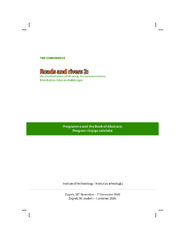Приказ основних података о документу
Lifeline of the frontier – Road and Port Network and Concept of Supply and Distribution in Moesia Superior
| dc.creator | Raičković Savić, Angelina | |
| dc.creator | Mrdjić, Nemanja | |
| dc.date.accessioned | 2023-11-20T12:20:36Z | |
| dc.date.available | 2023-11-20T12:20:36Z | |
| dc.date.issued | 2020 | |
| dc.identifier.isbn | 978-953-6064-58-8 | |
| dc.identifier.uri | http://rai.ai.ac.rs/handle/123456789/703 | |
| dc.description.abstract | Defining relationship between the Danube as a major river route and adjacent limes road with all its crossroads and shortcuts proved to be a challenging task. Both mili tary and civilians were focused on both routes exploiting them to the maximum. From the earliest decades after forming Moesia as a province, legions were tasked to build roads through some of the harshest terrains. Importance of these actions can be traced through time with tablets, both imperial and legionary celebrating these enormous undertaking absolutely necessary for the frontier to function. Plac ing and coordination of military distribution centers was crucial for supply of gar risons in smaller forts that had no facilities for long term storage of food. In theory major routes are simple and follow the course of river. In the field situation is far more complicated. Viminacium as a case study had its own network of roads directed towards all di rections with multiple roads intersecting and merging. Following the distribution of villas, cemeteries and production centers for almost 20 years to this date – a vivid network came to life. The city and legionary fortress were in the center of this spi der’s road net with Mlava and Danube to encircle and open it worldwide towards both east and west. Limes was the best economically developed region in Moesia Superior with most of its production potential focused on Danube for distribution. Local production of pottery and coinage from Viminacium mint found its way to remote provinces along this line. | sr |
| dc.language.iso | en | sr |
| dc.publisher | Zagreb : Institut za arheologiju | sr |
| dc.relation | The publication results from the project LIFE ON THE ROMAN ROAD: communications, trade and identities on Roman roads in Croatia from 1st – 8th CE, UIP-05-2017-9768, supported by Croatian Science Foundation. | sr |
| dc.rights | openAccess | sr |
| dc.source | Roads and rivers 2: the transformation of life along the communications from Roman times to middle ages : programme and the book of abstracts | sr |
| dc.subject | Moesia Superior | sr |
| dc.subject | Danube | sr |
| dc.subject | legionary fortress | sr |
| dc.subject | pottery | sr |
| dc.title | Lifeline of the frontier – Road and Port Network and Concept of Supply and Distribution in Moesia Superior | sr |
| dc.type | conferenceObject | sr |
| dc.rights.license | ARR | sr |
| dc.citation.epage | 9 | |
| dc.citation.spage | 9 | |
| dc.identifier.fulltext | http://rai.ai.ac.rs/bitstream/id/2682/bitstream_2682.pdf | |
| dc.identifier.rcub | https://hdl.handle.net/21.15107/rcub_rai_703 | |
| dc.type.version | publishedVersion | sr |


